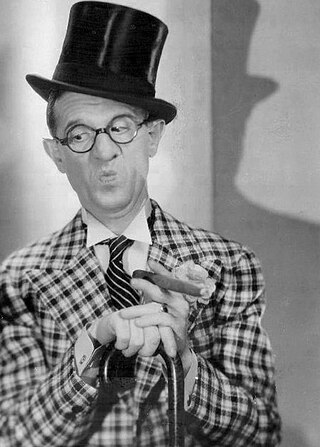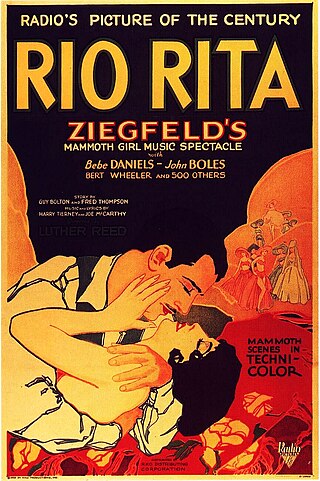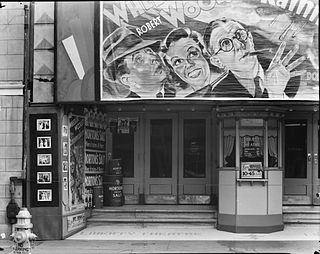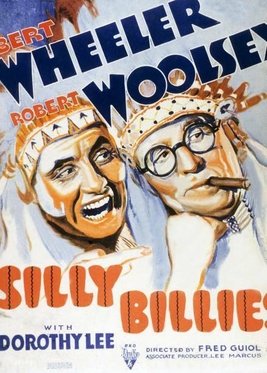
Hips, Hips, Hooray! is a 1934 American pre-Code slapstick comedy starring Bert Wheeler, Robert Woolsey, Ruth Etting, Thelma Todd and Dorothy Lee. During its initial theatrical run, it was preceded by the two-color Technicolor short Not Tonight, Josephine, directed by Edward F. Cline.

Wheeler & Woolsey were an American vaudeville comedy double act who performed together in comedy films from the late 1920s. The team comprised Bert Wheeler (1895–1968) of New Jersey and Robert Woolsey (1888–1938) of Illinois.

Albert Jerome Wheeler was an American comedian who performed in Broadway theatre, American comedy feature films, and vaudeville acts. He was teamed with Broadway comic Robert Woolsey, and they went on to fame as Wheeler & Woolsey.

Robert Rolla Woolsey was an American stage and screen comedian and half of the 1930s comedy team Wheeler & Woolsey.

Dixiana (1930) is a lavish American pre-Code comedy, musical film directed by Luther Reed and produced and distributed by RKO Radio Pictures. The final twenty minutes of the picture were photographed in Technicolor. The film stars Bebe Daniels, Everett Marshall, Bert Wheeler, Robert Woolsey, Joseph Cawthorn, Jobyna Howland, Ralf Harolde, Bill "Bojangles" Robinson and Dorothy Lee. The script was adapted by Luther Reed from a story by Anne Caldwell.

Rio Rita is a 1929 American pre-Code RKO musical comedy starring Bebe Daniels and John Boles along with the comedy team of Wheeler & Woolsey. The film is based on the 1927 stage musical produced by Florenz Ziegfeld, which originally united Wheeler and Woolsey as a team and made them famous. The film was the biggest and most expensive RKO production of 1929 as well as the studio's biggest box office hit until King Kong (1933). Its finale was photographed in two-color Technicolor. Rio Rita was chosen as one of the 10 best films of 1929 by Film Daily.

Dorothy Lee was an American actress and comedian during the 1930s. She appeared in 28 films, usually appearing alongside the comedy team of Bert Wheeler and Robert Woolsey.

Half Shot at Sunrise is a 1930 American pre-Code comedy film starring the comedy duo Wheeler & Woolsey and Dorothy Lee. Their fourth film together, it was the second starring vehicle for the two, following the success of The Cuckoos, which had been released earlier in 1930. Directed by Paul Sloane, from a screenplay by Anne Caldwell, James Ashmore Creelman, Ralph Spence, and Fatty Arbuckle, which had been tailored to highlight the comedic talents of Wheeler and Woolsey. In 1958, the film entered the public domain in the United States because the claimants did not renew its copyright registration in the 28th year after publication.
Cracked Nuts is a 1931 American pre-Code comedy film directed by Edward F. Cline, from an original screenplay written by Al Boasberg and Ralph Spence. The film stars the comedy duo Wheeler & Woolsey as well as Dorothy Lee. It also features Boris Karloff in a small supporting role. The film was one of RKO's only financial successes of the year, with a profit of just over $150,000.

Girl Crazy is a 1932 American pre-Code musical film adaptation of the 1930 stage play of the same name. The film was very unlike the stage play except for its score. It was tailored for the comic talents of Wheeler & Woolsey, a popular comedy team of the time. Three songs written by George and Ira Gershwin for the play were retained: "Bidin' My Time", "I Got Rhythm", and "But Not for Me". According to RKO records, the film lost $150,000. Lon Chaney Jr. appears in the film (uncredited) as a dancer in the chorus.

The Cuckoos is a 1930 American Pre-Code musical comedy film released by RKO Radio Pictures and partially filmed in two-strip Technicolor. Directed by Paul Sloane, the screenplay was adapted by Cyrus Wood from the 1926 Broadway musical The Ramblers by Guy Bolton, Bert Kalmar and Harry Ruby. The film stars Bert Wheeler and Robert Woolsey, and while they had appeared on Broadway and in other films together, this was their first time starring as a team. The success of this picture, combined with Rio Rita being their most successful film of 1929, convinced the studio to headline them as the comedy team Wheeler & Woolsey, through 1937.

Everything's Rosie is a 1931 American Pre-Code slapstick comedy film directed by Clyde Bruckman, from a screenplay by Ralph Spence, Tim Whelan, and Al Boasberg, based on a story by Boasberg. Although the screenplay was credited as original, it bore a striking resemblance to a 1923 play, Poppy, which had starred W. C. Fields.

Caught Plastered is a 1931 American Pre-Code musical comedy film, released by RKO Radio Pictures and starring the comedy team Wheeler & Woolsey.

Peach-O-Reno is a 1931 pre-Production Code comedy film starring Bert Wheeler, Robert Woolsey, Dorothy Lee, and Zelma O'Neal. It was released on Christmas Day of 1931. The title is a pun on "peacherino," then-popular slang for something more desirable or intense than just a simple peach, itself a complimentary term.

Sin Takes a Holiday is a 1930 American pre-Code romantic comedy film, directed by Paul L. Stein, from a screenplay by Horace Jackson, based on a story by Robert Milton and Dorothy Cairns. It starred Constance Bennett, Kenneth MacKenna, and Basil Rathbone. Originally produced by Pathé Exchange and released in 1930, it was part of the takeover package when RKO Pictures acquired Pathé that year; it was re-released by RKO in 1931.

Cockeyed Cavaliers is a 1934 American pre-Code comedy film starring the comedy duo of Wheeler & Woolsey. Directed by Mark Sandrich from a screenplay by Edward Kaufman, Grant Garrett, Ralph Spence and Ben Holmes. Also featured in the cast were Dorothy Lee and Thelma Todd.

The Nitwits is a 1935 American comedy film directed by George Stevens from a screenplay written by Fred Guiol and Al Boasberg, based on a story by Stuart Palmer. Released by RKO on June 7, 1935, the film stars the comedy duo of Wheeler & Woolsey, with featured roles being filled by Fred Keating, Betty Grable, Evelyn Brent and Erik Rhodes.

The Rainmakers is a 1935 American comedy film directed by Fred Guiol from a screenplay by Grant Garrett and Leslie Goodwins, based on a story by Guiol and Albert Traynor. RKO Radio Pictures released the film on October 25, 1935, starring the comedy team of Wheeler & Woolsey and Dorothy Lee.

Silly Billies is a 1936 American comedy film directed by Fred Guiol from a screenplay by Al Boasberg and Jack Townley, based on a story by Guiol and Thomas Lennon. The film was the twentieth feature for the comedy duo of Wheeler and Woolsey, and also stars Dorothy Lee, who had been in a number of their films. It was released by RKO Radio Pictures on March 20, 1936.

Hugh Trevor was an American actor whose short career began at the very end of the silent era in 1927. He would appear in nineteen films in the scant six years during which he was active. He did not fare well with the advent of talking pictures, and retired from the industry in 1931. His life was cut short when he unexpectedly died from complications following appendectomy surgery in 1933.



















